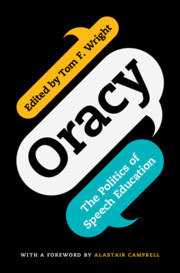
-
Select format
-
- Publisher:
- Cambridge University Press
- Publication date:
- September 2025
- July 2025
- ISBN:
- 9781009440301
- 9781009440318
- 9781009440325
- Dimensions:
- (229 x 152 mm)
- Weight & Pages:
- 0.472kg, 220 Pages
- Dimensions:
- (229 x 152 mm)
- Weight & Pages:
- 0.325kg, 220 Pages
- Subjects:
- Sociolinguistics, Education policy, strategy and reform, Education, Language and Linguistics
You may already have access via personal or institutional login- Subjects:
- Sociolinguistics, Education policy, strategy and reform, Education, Language and Linguistics
Book description
Oracy – or 'speaking and listening skills' – has become one of the most prominent ideas in modern education. But where has this idea come from? Should oracy education be seen as positive, or does it hold unintended consequences? How can problems over definitions, teaching and assessment ever be overcome? This timely book brings together prominent practitioners and researchers to explore the often overlooked implications of speaking and listening education. It features essays from teachers, school leaders, political advisers and charity heads, and from leading thinkers across the fields of linguistics, political science, history, Classics and anthropology. Together, they consider the benefits and risks of oracy education, place it in global context, and offer practical guidance for those trying to implement it on the ground. By demystifying one of the most important yet contentious ideas in modern education, this book offers a vital roadmap for how schools can make oracy work for all.
Contents
Metrics
Full text views
Full text views help Loading metrics...
Loading metrics...
* Views captured on Cambridge Core between #date#. This data will be updated every 24 hours.
Usage data cannot currently be displayed.
Accessibility standard: WCAG 2.2 AAA
Why this information is here
This section outlines the accessibility features of this content - including support for screen readers, full keyboard navigation and high-contrast display options. This may not be relevant for you.
Accessibility Information
The PDF of this book complies with version 2.2 of the Web Content Accessibility Guidelines (WCAG), offering more comprehensive accessibility measures for a broad range of users and attains the highest (AAA) level of WCAG compliance, optimising the user experience by meeting the most extensive accessibility guidelines.
Content Navigation
Table of contents navigation
Allows you to navigate directly to chapters, sections, or non‐text items through a linked table of contents, reducing the need for extensive scrolling.
Index navigation
Provides an interactive index, letting you go straight to where a term or subject appears in the text without manual searching.
Reading Order and Textual Equivalents
Single logical reading order
You will encounter all content (including footnotes, captions, etc.) in a clear, sequential flow, making it easier to follow with assistive tools like screen readers.
Short alternative textual descriptions
You get concise descriptions (for images, charts, or media clips), ensuring you do not miss crucial information when visual or audio elements are not accessible.
Full alternative textual descriptions
You get more than just short alt text: you have comprehensive text equivalents, transcripts, captions, or audio descriptions for substantial non‐text content, which is especially helpful for complex visuals or multimedia.
Visual Accessibility
Use of colour is not sole means of conveying information
You will still understand key ideas or prompts without relying solely on colour, which is especially helpful if you have colour vision deficiencies.
Use of high contrast between text and background colour
You benefit from high‐contrast text, which improves legibility if you have low vision or if you are reading in less‐than‐ideal lighting conditions.

